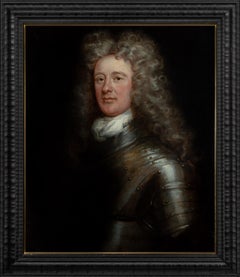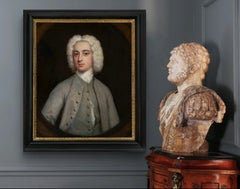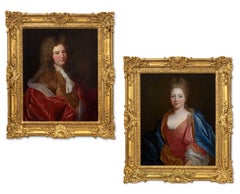Want more images or videos?
Request additional images or videos from the seller
1 of 12
Charles D'AgarPortrait of John Churchill, 1st Duke of Marlborough (1650-1722)circa 1695
circa 1695
$24,041.23List Price
About the Item
- Creator:Charles D'Agar (1669 - 1723)
- Creation Year:circa 1695
- Dimensions:Height: 57.49 in (146 cm)Width: 48.04 in (122 cm)Depth: 3.15 in (8 cm)
- Medium:
- Movement & Style:
- Period:
- Condition:
- Gallery Location:London, GB
- Reference Number:1stDibs: LU119915145712
About the Seller
5.0
Vetted Professional Seller
Every seller passes strict standards for authenticity and reliability
Established in 1998
1stDibs seller since 2019
45 sales on 1stDibs
Typical response time: 2 hours
Authenticity Guarantee
In the unlikely event there’s an issue with an item’s authenticity, contact us within 1 year for a full refund. DetailsMoney-Back Guarantee
If your item is not as described, is damaged in transit, or does not arrive, contact us within 7 days for a full refund. Details24-Hour Cancellation
You have a 24-hour grace period in which to reconsider your purchase, with no questions asked.Vetted Professional Sellers
Our world-class sellers must adhere to strict standards for service and quality, maintaining the integrity of our listings.Price-Match Guarantee
If you find that a seller listed the same item for a lower price elsewhere, we’ll match it.Trusted Global Delivery
Our best-in-class carrier network provides specialized shipping options worldwide, including custom delivery.You May Also Like
Portrait of Lady Caroline Price
By George Romney
Located in Miami, FL
DESCRIPTION: Perhaps the best Romney in private hands. If Vogue Magazine existed in the late 18th century, this image of Lady Caroline Price would be ...
Category
1970s Old Masters Portrait Paintings
Materials
Oil, Canvas
Fine Antique Classical Nude Draped in Robes Dancing with Dog Gold Background
Located in Cirencester, Gloucestershire
Artist/ School: Italian School, 19th century
Title: Classical nude draped in robes with dancing dog. The work looks as though it might have been a ceiling...
Category
19th Century Old Masters Nude Paintings
Materials
Oil, Canvas
$1,378 Sale Price
20% Off
H 35 in Dm 27 in
1600's Flemish Old Master Oil Painting The Virgin & Child Mastertpiece Work
Located in Cirencester, Gloucestershire
The Virgin & Child
Flemish School, circa 1600
circle of Cornelis van Cleve (Flemish c. 1520-1614),
oil painting on canvas
canvas: 37 x 30 inches
provenance: private collection, Paris...
Category
Early 17th Century Old Masters Portrait Paintings
Materials
Canvas, Oil
$9,037 Sale Price
54% Off
H 44 in W 36 in D 1 in
Fine Large 17th/ 18th Century English Portrait of Mr. Gilbert Charity Founder
Located in Cirencester, Gloucestershire
Portrait of Mr. Gilbert (believed to be the founder of 'Gilberts Charity, Bridgwater, Somerset)
English School artist, late 17th/ early 18th century
oil...
Category
Late 17th Century Old Masters Portrait Paintings
Materials
Oil, Canvas
$2,205 Sale Price
20% Off
H 30 in W 25 in
Large 1700's Italian Oil Painting on Canvas Portrait of a Clerical Gentleman
Located in Cirencester, Gloucestershire
Portrait of a Clerical Gentleman
Italian artist, mid 18th century
Circle of Giovanni Battista Carboni (1725-1790)
oil on canvas, unframed
canvas: 26 x 22 inches
provenance: private c...
Category
Mid-18th Century Old Masters Portrait Paintings
Materials
Oil, Canvas
$1,102 Sale Price
20% Off
H 26 in W 22 in
Large Antique Oil Painting The Mona Lisa after da Vinci's Famous Painting
Located in Cirencester, Gloucestershire
The Mona Lisa
after Leonardo da Vinci
French artist, 20th century
oil on canvas, unframed
canvas: 24 x 18 inches
provenance: private collection, Paris
condition: good and sound condi...
Category
20th Century Old Masters Portrait Paintings
Materials
Oil, Canvas
$4,849 Sale Price
20% Off
H 24 in W 18 in
Fine 17th Century Dutch Old Master Oil Painting Interior Scene Many Figures
Located in Cirencester, Gloucestershire
Alms for the Poor
by Richard Brakenburg (Flemish 1650-1702)
oil on canvas, unframed
Canvas: 25 x 30 inches
Provenance: private collection, France, extensively inscribed verso
Conditi...
Category
17th Century Old Masters Figurative Paintings
Materials
Oil, Canvas
$5,455 Sale Price
20% Off
H 25 in W 30 in
18th Century European Portrait of Saint John the Baptist as a Child.
Located in SANTA FE, NM
18th Century European Portrait of a Child Saint John the Baptist
Oil on Canvas
19 x 14 1/4 inches
This lovely and sensitively painting has been examined by a professional restorer w...
Category
18th Century Old Masters Figurative Paintings
Materials
Canvas, Oil
$7,600 Sale Price
20% Off
H 19 in W 14.25 in D 3 in
Italian Greyhound and Friends - Italian 17thC Old Master dog art oil painting
By Francesco Fieravino
Located in Hagley, England
This stunning Old Master 17th century oil portrait painting is attributed to Francesco Fieravino, an artist famous in his day for still lifes and carpets. This painting which dates t...
Category
17th Century Old Masters Animal Paintings
Materials
Canvas, Oil
$57,313 Sale Price
20% Off
H 27 in W 33 in D 2 in
King Charles 1st Antique Oil Painting Portrait of Famous British Monarch
Located in Cirencester, Gloucestershire
King Charles I
British artist, early 20th century
signed with initials
oil on canvas, framed
framed: 36 x 29 inches
canvas: 32 x 26 inches
provenance: p...
Category
Early 1900s Old Masters Portrait Paintings
Materials
Oil, Canvas
$1,543 Sale Price
20% Off
H 36 in W 29 in
More From This Seller
View AllPortrait of a Gentleman, David Erskine, 13th Laird of Dun, Wearing Armour c.1700
Located in London, GB
The gentleman in this exquisite oil on canvas portrait, presented by Titan Fine Art, is shown with the grandiloquence characteristic of the English School of painting. He is portray...
Category
17th Century Old Masters Portrait Paintings
Materials
Oil, Canvas
Portrait of a Gentleman in Grey Coat & White Cravat, Oil on canvas Painting
Located in London, GB
This exquisite work, presented by Titan Fine Art, is by the notable artist Hans Hysing, who was a noteworthy painter in England; it is significant in its q...
Category
18th Century Old Masters Portrait Paintings
Materials
Canvas, Oil
Portrait of Gentleman Blue & Cloak, Portrait of Lady, Fine Carved Gilded frames
Located in London, GB
Portrait of a Gentleman with Blue Cloak and Portrait of a Lady in Russet Dress c.1697
Thomas Murray (1663-1735)
These fascinating portraits are exquisite examples of portraiture in ...
Category
17th Century Old Masters Portrait Paintings
Materials
Oil, Canvas
Portrait of a Lady and Portrait of Gentleman, Velvet & Silk Attire c.1700 French
By Nicolas de Largillière
Located in London, GB
These lavish portraits, presented by Titan Fine Art, illustrate the elegant and exuberant type of portrait that the French court and the bourgeoisie favoured at the end of the 17th c...
Category
17th Century Old Masters Portrait Paintings
Materials
Canvas, Oil
Portrait of a Lady in Green Dress & Pearl Jewellery c.1660 Painting John Wright
By John Michael Wright
Located in London, GB
In this exquisite work, painted around the time of the Great Fire of London in 1666, a beautiful young woman is wearing a green dress over a white chemise and a russet-coloured scarf...
Category
17th Century Old Masters Portrait Paintings
Materials
Canvas, Oil
Portrait Gentleman Armour, Blue Cloak, Diamond Brooch c.1700 French Carved Frame
By Joseph Vivien
Located in London, GB
Portrait of a Gentleman in Armour and Azure Cloak with Diamond Brooch c.1700
Attributed to Joseph Vivienne (1657-1735)
The sitter in this superb portrait, offered by Titan Fine Art...
Category
17th Century Old Masters Portrait Paintings
Materials
Oil, Cotton Canvas
Recently Viewed
View AllMore Ways To Browse
George Vertue
Sir Winston
Jacques Jacob
Paintings By Winston Churchill For Sale
Charles Agar
Viktoria Canvas
William Wilberforce
Winston Churchill Portrait
Yuval Mahler On Sale
16th Century Frame German
17th C Dutch Portraits
18th Century Military Portrait
18th Century Portrait Of Lady By A Sweden
18th Century Scottish Portrait
Alois Priechenfried
Ambrose Mcevoy
Antoine Pesne
Charles Laval



